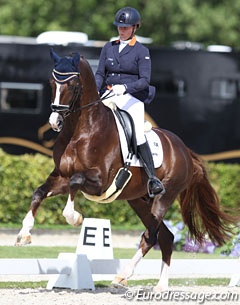
Do you work on the quality of the canter? Often I see riders who can canter and do the exercises, but they don’t spend enough time improving the gait itself. The trot is a gait that is worked on a lot, as riders believe that the quality, cadence, and expression of the trot can be improved. So why not the canter?
I am a rider who has at times tended to avoid the canter work. I am not sure why. Do you sometimes start the lesson in trot and finish in trot, and do quite a lot of shoulder-in, travers, and lateral work at the trot, and then canter for a little bit and then trot stretch at the end? Unless the canter is your focus then often it is not given the necessary attention it deserves. I believe that most horses can perform many of the canter exercises even if they do not have a good quality canter. That’s not to say the exercises are done well, just that they are done.
So, to address some of the major canter issues, I'll touch back on my idol, Nuno Oliveira, who said, “the quality of the canter depends on the quality of the walk (or trot) that proceeds it." This means that if you depart from a bad walk, than you cannot expect a good canter. Yet we see this all the time. The rider decides it’s time to start the canter work, and off they go into canter without first taking the time to make sure the walk (or trot) has a good rhythm and balance and very importantly that the horse is straight! I cannot tell you how many times I have seen a horse depart to the canter with his quarters in, and then of course continue to canter with his quarters in for the duration of the canter.
The second issue is that often, particularly with young horses, the horse can become excited. This in fact was the reason why I avoided it sometimes in training. If it was a windy day, or my horse was feeling a little fresh, when I would begin the canter he would get “playful” and I would feel less in control. One particularly useful way to help this is on a 20 metre circle, go from trot to canter and back again, making sure to relax the horse in the trot before starting the canter again. Nuno often talked about horses who “panicked” in the canter: “With a horse that panics in the canter, ask for many transitions trot -canter-trot- canter, without departing to the canter until you feel that the trot is relaxed enough.”
The other mistake we see a lot is riders trying to slow the horse's canter by pulling on the reins. “We must slow the canter by the waist, not by the hands," said Nuno.
Learning to ride the canter takes time and thought. Learning to slow the canter with the use of the body and not the reins even more so. Aim to do the transition back over several strides. I often see riders who want to slow the canter in one stride before the horse has correctly learnt the seat aid, and so the rider needs to use strong reins and the horse contracts and gets tense through the body. Take your time to feel the canter and ask gently for the horse to go on and come back within the canter slowly as he learns how your seat is asking him.
The next common problem is the horse that canters with his quarters to the inside. If you are on the horse you may not feel this. Often you need someone on the ground, or a video directly behind you to see it. Watch at the next competition how many horses enter at canter with their bum curved around toward the leading leg. Once a rider learns that the horse is putting his quarters to the inside they try to correct it by bending the horse to the inside. Wrong.
“Too much inside rein in the canter makes the horse brace to the inside. If in the canter to the right the horse is not straight and keeps his haunches to the right, the more you use the right rein and place the head to the right, the more he will place his haunches to the right. It is the left rein you need to use to place the shoulders in front of the haunches and then go back to the track," Oliviera explained.
It is the outside rein that places the shoulders to the inside, so they are in line with the haunches and you can move the horse back to the track and on the straight line.
Another canter trap is to use too much rein and leg at the canter. The torso controls the canter. Next time you canter think of lifting you torso up and then engaging your core muscles, and then try to move with the horse. Once you can move with him you can use your core to slow him down and then you can search for true collection in canter.
by Sarah Warne - Photo © Astrid Appels
Related Link
Sarah Warne's Classical Training Articles on Eurodressage